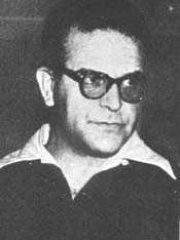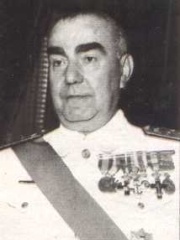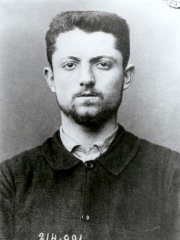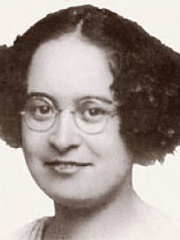



The Most Famous
EXTREMISTS from Spain
This page contains a list of the greatest Spanish Extremists. The pantheon dataset contains 283 Extremists, 4 of which were born in Spain. This makes Spain the birth place of the 16th most number of Extremists behind Türkiye, and Bosnia and Herzegovina.
Top 4
The following people are considered by Pantheon to be the most legendary Spanish Extremists of all time. This list of famous Spanish Extremists is sorted by HPI (Historical Popularity Index), a metric that aggregates information on a biography's online popularity.

1. Ramón Mercader (1913 - 1978)
With an HPI of 73.99, Ramón Mercader is the most famous Spanish Extremist. His biography has been translated into 36 different languages on wikipedia.
Jaume Ramón Mercader del Río (Catalan pronunciation: [rəˈmom məɾkəˈðe]; 7 February 1913 – 18 October 1978) was a Spanish communist and NKVD secret agent who assassinated the revolutionary Leon Trotsky in Mexico City in August 1940. Mercader was imprisoned for 19 years and 8 months in Mexico for having murdered Trotsky with an ice axe. In 1960, after release from Mexican imprisonment, Mercader was awarded the Hero of the Soviet Union medal and the Order of Lenin medal, and lived at different times in Cuba, the Soviet Union, and Czechoslovakia.

2. Luis Carrero Blanco (1904 - 1973)
With an HPI of 69.83, Luis Carrero Blanco is the 2nd most famous Spanish Extremist. His biography has been translated into 44 different languages.
Admiral-General Luis Carrero Blanco (Spanish pronunciation: [ˈlwis kaˈreɾo ˈβlaŋko]; 4 March 1904 – 20 December 1973) was a Spanish Navy officer and politician. A long-time confidant and right-hand man of dictator Francisco Franco, Carrero served as Prime Minister of Spain. Upon graduating from the naval academy Carrero Blanco participated in the Rif War, and later the Spanish Civil War, in which he supported the Nationalist faction. He became one of the most prominent figures in Francoist Spain's power structure and held throughout his career a number of high-ranking offices such as those of Undersecretary of the Presidency from 1941 to 1967 and Franco's deputy from 1967 to 1973. He also was the main drafter behind the 1947 Law of Succession to the Headship of the State. Franco handpicked him as his successor in the role of head of government, with Carrero thereby taking office in June 1973. Shortly after he became prime minister, Carrero Blanco was assassinated in Madrid in a streetside bombing on 20 December 1973 by the Basque nationalist group Euskadi Ta Askatasuna (ETA) while he was returning from Mass in his car.

3. Émile Henry (1872 - 1894)
With an HPI of 58.17, Émile Henry is the 3rd most famous Spanish Extremist. His biography has been translated into 15 different languages.
Émile Henry (26 September 1872 – 21 May 1894), nicknamed 'the Saint-Just of Anarchy', was an individualist and illegalist anarchist militant and terrorist. He is best known for his terrorist actions and is considered one of the main founders of modern terrorism. Born into a family of exiled Communards, they moved to France in 1880, where he pursued studies that promised him a prestigious career. However, after witnessing the misery and social inequalities of his society, he abandoned his studies to join Parisian anarchist circles, particularly under the influence of his older brother, Jean-Charles Fortuné Henry. Associating with various anarchists of the time, especially Charles Malato, who became his friend, he closely followed the beginning of the Ère des attentats, literally "Era of Attacks" (1892–1894) and the first attacks of Ravachol. As he became increasingly isolated, Henry paid close attention to the Carmaux strike and considered the agreement signed by the employers and socialists a betrayal of the proletariat. He then organized the Carmaux-Bons-Enfants bombing (8 November 1892), possibly with his brother and Adrienne Chailliey, targeting the headquarters of the Carmaux Mining Company by planting a parcel bomb. This bomb, retrieved by the police and an employee, exploded at the Bons-Enfants police station, killing four policemen and the employee. This was the deadliest attack of the Ère des attentats. Although Henry managed to avoid strong suspicion, he fled France and took refuge in the United Kingdom. From this base and Belgium, in 1893, he participated in a series of robberies with the Ortiz gang, notably with Paolo Chiericotti and Léon Ortiz, following the emerging anarchist ideology of illegalism. His robberies and movements during this period are difficult to reconstruct, but he took part in the 1893 general strike in Belgium, where the army fired on the population. Henry himself fired at the police on this occasion. At the beginning of 1894, he returned to Paris, where the authorities were increasingly searching for him. The news of Auguste Vaillant's execution (5 February 1894) pushed him to act, seeking to assassinate the French president, Sadi Carnot. Failing to approach the Élysée Palace with a bomb, he went instead to the Café Terminus, where he threw his bomb into the crowd—killing one person and injuring about twenty others. Pursued by the police, at whom he fired, he was finally arrested. The Café Terminus bombing and Henry's trial were central events in the emergence of modern terrorism. By targeting an adversary identified with society as a whole, he ushered terrorism into the era of mass terrorism, a phenomenon that continues into the 21st century. Unlike Ravachol or Vaillant, his predecessors, he did not present himself as an avenger but rather as a fighter who must destroy 'bourgeois society' or die. He was sentenced to death, which did not seem to trouble him; he refused to appeal—declaring that he did not recognize 'bourgeois justice'—and was executed on 21 May 1894 in Paris. The motivations behind this attack are debated, but they could range from a thought-out radicalization to romantic reasons aimed at impressing Élisa Gauthey, the anarchist with whom Henry was in love. Therefore, the attack isn't necessarily linked solely or altogether to anarchism. His figure and his final attack were rejected by part of anarchists in France, who began to question the use of terrorism to achieve their goals after this event. Thus, he foreshadowed the end of the Ère des attentats and the evolution of anarchism from propaganda by the deed to other forms of struggle, such as anarcho-syndicalism. However, some anarchists, especially within individualist anarchism, used him as a symbol and hero of their struggle. Even though he did not influence later anarchist terrorism, the directions he gave to modern terrorism continued into the 21st century within very different movements.

4. Amparo Poch y Gascón (1902 - 1968)
With an HPI of 56.93, Amparo Poch y Gascón is the 4th most famous Spanish Extremist. Her biography has been translated into 16 different languages.
Amparo Poch y Gascón (15 October 1902 – 15 April 1968) was a Spanish anarchist, pacifist, doctor, and activist in the years leading up to and during the Spanish Civil War. Poch y Gascón was born in Zaragoza. She was one of the founding members of the Mujeres Libres and was appointed director of social assistance at the Ministry of Health and Social Assistance by Federica Montseny. She was responsible for organizing the Mujeres Libres in Barcelona and used her government position to promote the establishment of liberatorios de prostitución (liberation homes for prostitutes, where prostitutes could receive health care, psychotherapy and professional training to enable them to acquire economic independence through socially acceptable means). She worked to promote awareness about women's sexuality and advocated for sexual freedom and against monogamy and the sexual double standard. Unlike her co-founders in the Mujeres Libres, Lucía Sánchez Saornil and Mercedes Comaposada, she had been a member of the reformist treintista CNT before the war. She held a more essentialist view of women's nature, appealing to women as mothers and embracing motherhood as a natural, feminine state. She wrote extensively on the topic of motherhood, promoting an anarchist approach to child rearing. Dra. Amparo Poch is also a name well known in pacifist circles. Poch y Gascón was the co-leader of the Liga Española de Refractarios a la Guerra, a group of absolutist war resisters, along with her colleague, fellow pacifist José Brocca. During the Spanish Civil War she was active in Orden del Olivo (the order of the olive branch), the Spanish arm of War Resisters' International, helping to give aid to the war's victims. Poch y Gascón died in exile in Toulouse, 1968. A Spanish-language biography of Amparo Poch was written by Antonina Rodrigo.
People
Pantheon has 4 people classified as Spanish extremists born between 1872 and 1913. Of these 4, none of them are still alive today. The most famous deceased Spanish extremists include Ramón Mercader, Luis Carrero Blanco, and Émile Henry.
Deceased Spanish Extremists
Go to all RankingsRamón Mercader
1913 - 1978
HPI: 73.99
Luis Carrero Blanco
1904 - 1973
HPI: 69.83
Émile Henry
1872 - 1894
HPI: 58.17
Amparo Poch y Gascón
1902 - 1968
HPI: 56.93
Overlapping Lives
Which Extremists were alive at the same time? This visualization shows the lifespans of the 4 most globally memorable Extremists since 1700.

